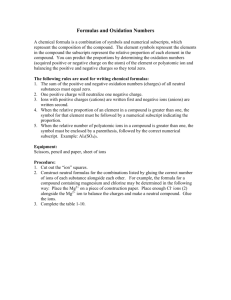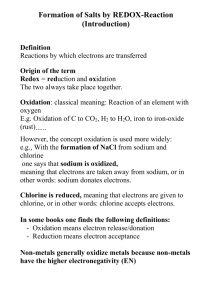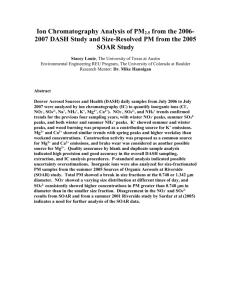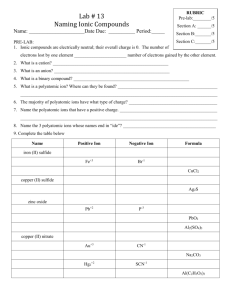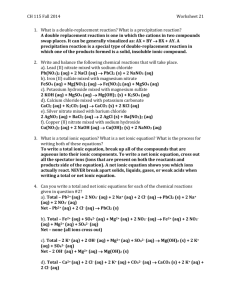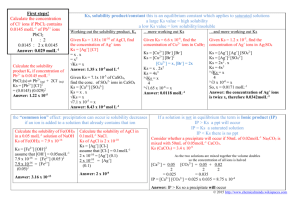Formulas and Oxidation Numbers Lab
advertisement
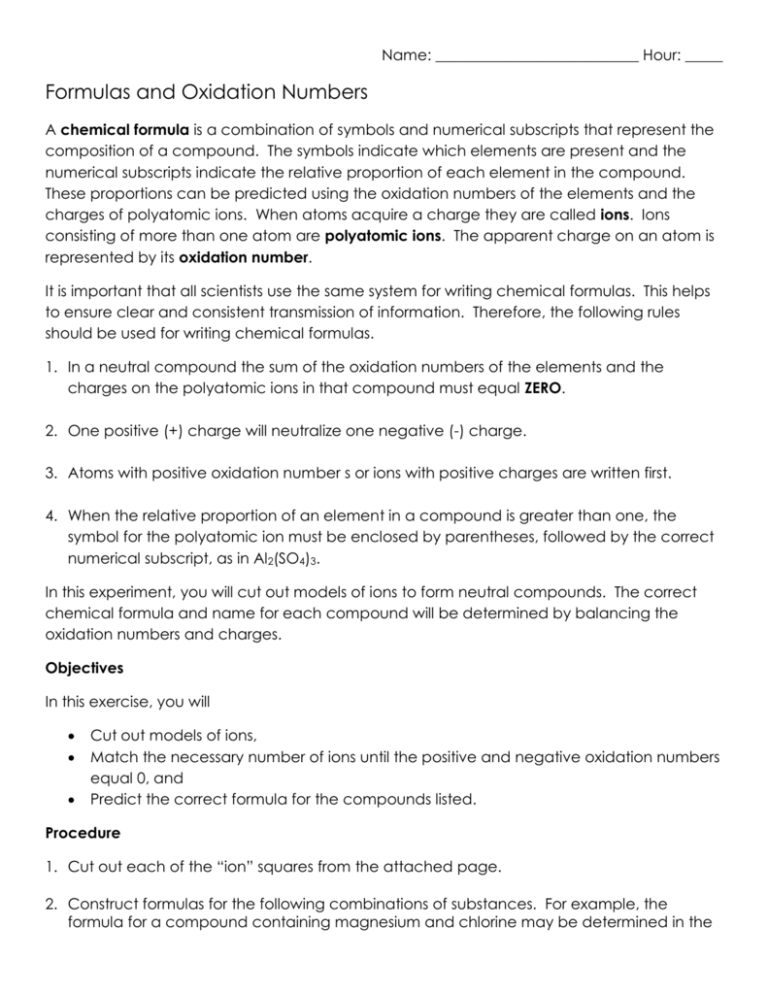
Name: ___________________________ Hour: _____ Formulas and Oxidation Numbers A chemical formula is a combination of symbols and numerical subscripts that represent the composition of a compound. The symbols indicate which elements are present and the numerical subscripts indicate the relative proportion of each element in the compound. These proportions can be predicted using the oxidation numbers of the elements and the charges of polyatomic ions. When atoms acquire a charge they are called ions. Ions consisting of more than one atom are polyatomic ions. The apparent charge on an atom is represented by its oxidation number. It is important that all scientists use the same system for writing chemical formulas. This helps to ensure clear and consistent transmission of information. Therefore, the following rules should be used for writing chemical formulas. 1. In a neutral compound the sum of the oxidation numbers of the elements and the charges on the polyatomic ions in that compound must equal ZERO. 2. One positive (+) charge will neutralize one negative (-) charge. 3. Atoms with positive oxidation number s or ions with positive charges are written first. 4. When the relative proportion of an element in a compound is greater than one, the symbol for the polyatomic ion must be enclosed by parentheses, followed by the correct numerical subscript, as in Al2(SO4)3. In this experiment, you will cut out models of ions to form neutral compounds. The correct chemical formula and name for each compound will be determined by balancing the oxidation numbers and charges. Objectives In this exercise, you will Cut out models of ions, Match the necessary number of ions until the positive and negative oxidation numbers equal 0, and Predict the correct formula for the compounds listed. Procedure 1. Cut out each of the “ion” squares from the attached page. 2. Construct formulas for the following combinations of substances. For example, the formula for a compound containing magnesium and chlorine may be determined in the following way. Place the Mg2+ ion on a piece of paper. Place enough Cl- ions alongside the Mg2+ ion to balance the charges. (Positive charges must equal negative charges.) See below. - + - Cl- Mg2+ Cl+ Magnesium and chlorine Magnesium chloride MgCl2 3. Predict formulas for five additional compounds using the ions provided in this experiment. Combining Substances Aluminum and bromine Sodium and oxygen Iron(II) and sulfur Aluminum and nitrate ion Potassium and sulfate ion Iron(III) and chlorine Ammonium ion and sulfur Aluminum and oxygen Iron(III) and sulfate ion Sodium and phosphate ion Analysis Construct the compounds as indicated above. Glue the compounds onto a blank sheet of paper. Next to each compound, write the name of the combining substances, the name of each compound formed, and the formula for each compound. + + Mg2+ Mg2+ Mg2+ + + + Al3+ + Al3+ + Al3+ + Al3+ + + + + + + + + + + + + + + + Fe3+ + Fe3+ + Fe3+ + Fe3+ + Fe2+ Fe2+ Fe2+ + + + + + + + + + + + + + + + + Na+ + Na+ + K+ Cl- Cl- NO3- Cl- NO3- - O2- Cl- Br- - O2- NO3- Br- - O2- NH4+ - - O2- Cl- NO3- Br- NO3- Br- O2- Cl- - - - K+ - - - - K+ + - NH4+ - - Na+ + NH4+ - - Na+ + NH4+ - - Na+ + K+ - - Mg2+ + + Na+ - + + Fe2+ - + NO3- - Br- - O2- Br- - S2- S2- - - - - - - - - - - - - - - - - S2- S2- SO42- SO42- - - - - - - - - - PO43- - PO43- - PO43- - PO43- - - - - SO42- SO42- SO42- SO42-
